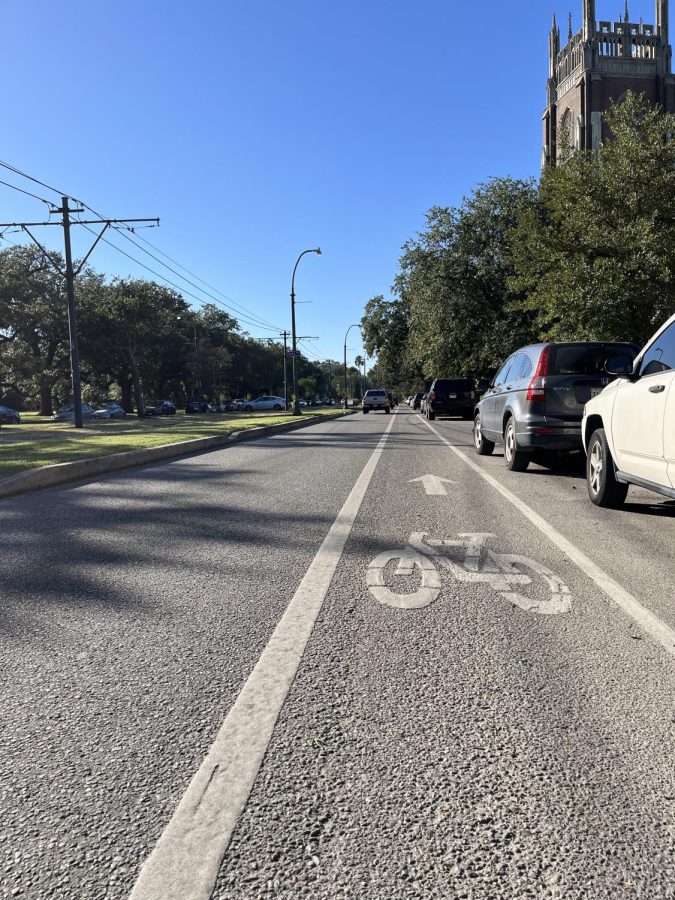Bike infrastructure removal causes mixed reactions
Bike lane without barriers near Loyola University New Orleans.
October 4, 2022
In response to community concerns, District C Councilman Freddie King III proposed an ordinance to remove bike lane infrastructure, such as flex posts and concrete barriers, from parts of Algiers.
The unanimous council vote will remove bike infrastructure from 2.2 miles of the total area of Algiers. The infrastructure will be removed from Newton Street and MacArthur Boulevard, King said. The area is less than half of the bike infrastructure in Algiers and about one percent of the bike lane infrastructure throughout the city as a whole, according to King.
This decision came with mixed reactions from the Greater New Orleans community. Some cycling activists said this move makes biking dangerous in the Algiers area whereas other community members supporting the decision cited that the barriers prohibited their way of life.
Algiers resident and Loyola nursing sophomore Zoe Nisse said she is glad that the infrastructure is being removed.
“We were fine with the bike lanes of course, but the only thing that really upset the neighborhood was them putting up the barriers,” Nisse said. “They did that without any input from the community.”
Nisse added that the impact the infrastructure has on parking is dangerous for personal safety.
“This could go for males but for mostly females, we don’t want to park blocks away from our house and walk alone at night. The crime rates being super high definitely affects it.”
The Department of Public Works will now have 60 days to return the streets to their previous configuration, without the additional bike lane infrastructure, though the bike lanes in Algiers will remain in place.
According to King, the overwhelming majority of the constituents of Algiers asked the infrastructure be removed with 230 people signing in support of removal and 25 asking for the infrastructure to stay. Out of those 25 people who wanted to keep the bike infrastructure in the area, only 15 of those individuals were from Algiers, King said.
But the president of the organization Crescent City Cyclists Thomas Rogers, said the removal of bike infrastructure endangers the safety of cyclists.
“Concrete barriers and posts are the safest method to protect bicyclists from traffic. I’ve cycled on St. Charles Avenue which just has a line, and people block it,” he said.
Roger’s concerns about the safety of biking without these barriers are not unwarranted as at least 18 people have been arrested for hit and run driving so far this year – not including other crimes such as driving under the influence, vehicular homicide, vehicular negligent injuring or first degree vehicular negligent injuring.
The concrete barriers and flex posts serve as a reminder to drivers to watch out for cyclists on the road. Rogers agrees that these barriers are one of the only things keeping cars from interacting with cyclists.
According to the National Highway Traffic Safety Administration, 932 bicyclists were killed in motor-vehicle traffic crashes in 2020, an 8.9% increase from 856 in 2019. Louisiana was one of the five states with the highest bicyclist fatality rates from 2014 through 2016, according to the National Transportation Safety Board.
Several New Orleans cyclists have died in vehicle-related incidents, as seen by the white “ghost” bikes around the city that honor those who have died.
Nisse and King argued that many people in Algiers don’t even bike on the two roads where infrastructure is being removed.
“I barely see anyone riding a bike in Algiers, and most residents of Algiers don’t work in Algiers, so they have to drive,” Nisse said.
King agreed with Nisse that the bike infrastructure isn’t highly trafficked in that area of Algiers.
“Myself and the Department of Public Works have sat outside one morning in Algiers discussing this issue, and we collectively counted one person riding a bike,” King said. “You can make an argument that maybe other parts of the city need it, but the main issue is that the city did not talk to us.”
King said District C residents want to hit the reset button and have a say in where the bike infrastructure is installed.
The City of New Orleans communications team declined to comment on this matter.
Rogers said it’s normal that the community may be resistant to changes on the road. He added that when the Mississippi River trail was being built, many community members at a River Ridge Civic Association meeting opposed the biking trail, citing that it would raise crime rates and disrupt the community.
“Now if you tried to take the Mississippi River Trail away, I think there’d be a hue and cry saying leave this up here because this is a good exercise venue,” Rogers said.
Rogers said having protected bike lanes encourages more people in the community to get out and bike. “It improves the health of the community because more people are out exercising.”
King said he will continue to work with the community to see where this infrastructure is needed most.
“We are definitely willing to work with the New Orleans Complete Streets Coalition and the Department of Public Works again and with members of the community to figure out what’s the best location and style for these protected bike lanes,” King said.









